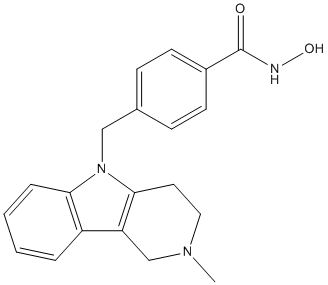All AbMole products are for research use only, cannot be used for human consumption.

Tubastatin A is a potent and selective HDAC6 inhibitor with IC50 of 15 nM. It is selective against all the other isozymes (1000-fold) except HDAC8 (57-fold).

University of Otago. 2019.
Transcriptional effects of mood stabiliser drugs in a serotonergic cell line
Tubastatin A purchased from AbMole
| Cell Experiment | |
|---|---|
| Cell lines | normal human (i.e., H69) and rat (NRC) cholangiocyte cell lines |
| Preparation method | Proliferation assays Proliferation assays were conducted using the CellTiter 96 AQueous Non-Radioactive Cell Proliferation Assay (MTS; Promega) and/or counting cells using the Cellometer Auto4 (Nexcelom Bioscience) cell counter. |
| Concentrations | 0, 4 µ M |
| Incubation time | 3 days |
| Animal Experiment | |
|---|---|
| Animal models | orthotopic, syngeneic CCA model in rats |
| Formulation | saline |
| Dosages | 10 mg/kg daily for 7 days |
| Administration | intraperitoneally |
| Molecular Weight | 335.4 |
| Formula | C20H21N3O2 |
| CAS Number | 1252003-15-8 |
| Solubility (25°C) | DMSO 9 mg/mL |
| Storage |
Powder -20°C 3 years ; 4°C 2 years In solvent -80°C 6 months ; -20°C 1 month |
| Related HDAC Products |
|---|
| CM-444
CM-444 is an inhibitor for HDAC and DNA methyltransferases (DNMT) with IC50 values of 6 nM-0.6 μM and 1.8-2.3 μM, respectively. CM-444 is an inducer for the differentiation of acute myeloid leukemia cells. CM-444 exhibits anti-leukemic activity and improves the survival rate in mouse models. |
| CM-1758
CM-1758 is a histone deacetylase (HDAC) inhibitor. CM-1758 inhibits tumor growth in vivo. CM-1758 induces acetylation of non-histone proteins in acute myeloid leukemia cells. |
| T-518
T-518 is an orally active, selective, and blood-brain barrier permeable HDAC6 inhibitor with an IC50 value of 36 nM for human HDAC6. |
| SE-7552
SE-7552, a 2-(difluoromethyl)-1,3,4-oxadiazole (DFMO) derivative, is an orally active, highly selective, non-hydroxamate HDAC6 inhibitor with an IC50 of 33 nM. |
| BRD9757
BRD9757 is a potent, capless and selective HDAC6 inhibitor with an IC50 of 30 nM. |
All AbMole products are for research use only, cannot be used for human consumption or veterinary use. We do not provide products or services to individuals. Please comply with the intended use and do not use AbMole products for any other purpose.


Products are for research use only. Not for human use. We do not sell to patients.
© Copyright 2010-2024 AbMole BioScience. All Rights Reserved.
